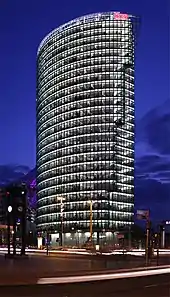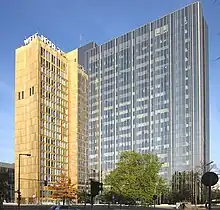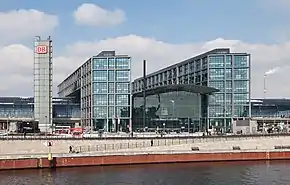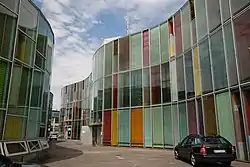Economy of Berlin
The economy of Berlin is dominated by the service sector, with around 84% of all companies doing business in services. Important economic sectors in Berlin include life sciences, transportation, information and communication technologies, media and music, advertising and design, biotechnology, environmental services, construction, e-commerce, retail, hotel business, and medical engineering.[1]

Berlin became one of the largest and most advanced industrial centers in Europe after 1870. After 1900 the Berlin banking district became a major continental financial center and was home to a number of prominent banks. After the end of World War II in 1945 and the subsequent political divisions, the city's location inside of East Germany led to an exodus of many major firms to West Germany. Berlin's economy has been affected through the years by the city's changing geopolitical fortunes from 1961-1989. The city stagnated economically during the Cold War, when West Berlin was isolated geographically and East Berlin suffered from poor economic decisions made by East Germany’s socialist central planners. Furthermore, few East German companies survived the collapse of the GDR and the attempt to privatize them through the Treuhandanstalt.
After German reunification in 1990 large service, technology and creative sectors re-established in the city. A number of companies have re-opened secondary corporate headquarters or satellite offices in Berlin. A number of major German companies were founded in Berlin, such as Siemens, Deutsche Bank, Lufthansa, Allianz, AEG, Telefunken, Osram, Knorr-Bremse and Edeka.
History
Berlin was founded at a point where trade routes crossed the river Spree and it quickly became a commercial center. During the early modern period, the city prospered from its role as Prussian capital by manufacturing luxury goods for the Prussian court and supplies for the Prussian military.
Industrial Revolution

During the mid-19th century, the Industrial Revolution transformed the city’s economy. Berlin became Germany’s main rail hub and a center of locomotive manufacturing. The city became a leader in the manufacture of other kinds of machinery as well, and developed an important chemical industry sector. Toward the end of the 19th century, Berlin became a world leader in the then cutting-edge sector of electrical equipment manufacturing. As the de facto center of the German Zollverein, or Customs Union, and later the seat of the Reichsbank, Berlin became Germany’s banking and financial center as well.
Berlin suffered from both the German hyperinflation of the 1920s and the Great Depression of the 1930s. The city’s economy revived as a center of weapons production under the Nazis, but it lost a pool of entrepreneurial talent when the Nazis forced Jewish businessmen to sell their holdings and ultimately massacred most who did not flee Germany.
After the World Wars
World War II severely damaged Berlin’s industrial infrastructure, and Soviet expropriation of machinery and other capital equipment as “war reparations” further damaged Berlin’s industrial base. Soviet restrictions on transport impeded communication with West Germany and ended hopes that Berlin would resume a role as Germany’s financial center; most banks established headquarters in Frankfurt. In East Berlin, socialist central planners rebuilt a manufacturing sector, but one that was not competitive internationally or responsive to market demand. West Berlin’s economy grew increasingly dependent on state subsidies and on its role as an educational and research center.
Reunification

Berlin’s and Germany’s unification brought the collapse of many of East Berlin’s producers, which could not compete with market-disciplined Western competitors. Massive unemployment was only partly compensated by the growth of jobs in the construction and infrastructural sectors involved in rebuilding and upgrading East Berlin’s infrastructure. The move of the federal government from Bonn to Berlin in 1999 brought some economic stimulus and tens of thousands of jobs from government employees, parliamentary services, lobbyists and journalism to Berlin. Berlin’s service sectors have also benefited from improved transportation and communications links to the surrounding region.
While some manufacturing remains in the city (Siemens and Bayer Schering Pharma have headquarters in Berlin), the service sectors have become the city’s economic mainstay. Research and development have gained significance, and Berlin was ranked among the top three innovative regions in the EU (after Baden-Württemberg and the Île-de-France in 2006.[2] In the same year unemployment remained high, at 16.5% as of 2006.[3]
Fast-growing sectors are communications, life sciences, mobility and services with information and communication technologies, media and music, advertising and design, biotechnology and environmental services, transportation and medical engineering.[4] Since 2015 Berlin is the top congress city in the world and is home to one of Europe's biggest convention centers in the form of the CityCube Berlin (formerly Internationales Congress Centrum). It contributes to the increasing tourism sector encompassing 592 hotels with 90,700 beds (2007 figures) and numbered over 22 million overnight stays by 9.8 million tourists in 2011.[5] Berlin has established itself as the third most visited city destination in the European Union.[6][7]
Berlin's economy has grown continuously above the German average in the period from 2005 to 2013.[8] This trend is set to continue, with important improvements to infrastructure, such as the biggest European crossing station, Berlin Hauptbahnhof (inaugurated 2006), the opening of the 3rd biggest German airport, Berlin Brandenburg Airport, in 2020 replacing the decrepit Tegel Airport which was not fit to serve as a modern airline hub.[9]
Also, the revered Berlin music scene, attracting tens of thousands of young tourists flying in for the city's famed clubs[10][11] has become an increasingly important part of the economy and is set to gain the support of the city music board modeled after the German film promotion authority.[12]
Workforce
Companies

The state-owned railway, Deutsche Bahn, has its headquarters in Berlin.[18] Many German and international companies have business or service centres in the city.
Among the 20 largest employers in Berlin are the Deutsche Bahn, the hospital providers, Charité and Vivantes, the local public transport provider, BVG, Siemens, and the telecommunications company Deutsche Telekom. Daimler manufactures cars, and BMW manufactures motorcycles in Berlin. Bayer Pharmaceuticals and Berlin Chemie are major pharmaceutical companies headquartered in the city.
Some other notable companies with their headquarters in Berlin are 50Hertz Transmission GmbH, Axel Springer SE,[19] Bombardier Transportation,[20] Bundesdruckerei, KPMG Deutschland, Alba Group, Otis Deutschland, Universal Music Germany,[21] Coca-Cola European Partners Deutschland, Delivery Hero, Lloyds Banking Group Europe,[22] solarisBank, N26, Pfizer Germany, Zalando, GASAG, HelloFresh, Deutsche Wohnen, and Vattenfall Deutschland.[23]
The top 10 largest employers in Berlin by number of employees in 2016:[24]
| Rank | Name | Employees (31 December 2016) | Sector |
|---|---|---|---|
| 1 | Deutsche Bahn (incl. Berlin S-Bahn) | 20,780 | Transport/Logistics |
| 2 | Charité | 17,083 | Health |
| 3 | Vivantes | 15,467 | Health |
| 4 | Berliner Verkehrsbetriebe | 14,417 | Transport |
| 5 | Siemens | 11,600 | Technology |
| 6 | Deutsche Post DHL | 10,000 | Logistics |
| 7 | Daimler AG | 8,800 | Automobile |
| 8 | Deutsche Telekom | 8,030 | Telecommunications |
| 9 | Deutsches Rotes Kreuz | 7,500 | Health/Aid |
| 10 | Zalando | 6,700 | Online commerce |
Tourism

Berlin has 788 hotels with 134,399 beds as of December 2014.[25] In 2016 the visitor figures for Berlin have broken records with 31.1 million overnight stays (+2.7%) and 12.9 million hotel guests (+2.9%). Berlin has a yearly total of estimated 135 million day visitors, which puts it in third place among the most-visited city destinations in Europe. International visitors made up 46 per cent of the overnight stays in 2016. The largest visitor groups are from Germany, the United Kingdom, the United States, Spain, Italy, the Netherlands, France, Switzerland, Denmark, Sweden and Poland.[26]
According to ICCA statistics in 2015 Berlin became the top organizer of conferences in the world hosting 195 international meetings.[27] It is home to one Europe's biggest convention centers at the Messe Berlin. Several large-scale trade fairs like the consumer electronics trade fair IFA, the ILA Berlin Air Show, Berlin Fashion Week (including the Bread and Butter tradeshow), Green Week ("Grüne Woche"), the transport fair InnoTrans, the adult entertainment fair Venus and the tourism fair ITB are held in the city.
Media

Berlin is home to many international and regional television and radio stations.[28] The public broadcaster RBB has its headquarters in Berlin as well as the commercial broadcasters MTV Germany, Comedy Central and Welt. German international public broadcaster Deutsche Welle has its TV production unit in Berlin, and most national German broadcasters have a studio in the city including Das Erste, ZDF and RTL.
Berlin has Germany's largest number of daily newspapers, with numerous local broadsheets (Berliner Morgenpost, Berliner Zeitung, Der Tagesspiegel), and three major tabloids, as well as national dailies of varying sizes, each with a different political affiliation, such as Die Welt, Junge Welt, Neues Deutschland, and Die Tageszeitung. The Exberliner, a monthly magazine, is Berlin's English-language periodical focusing on arts and entertainment. Berlin is also the headquarters of the two major German-language publishing houses Walter de Gruyter and Axel Springer, each of which publish books, periodicals, and multimedia products.
Creative industries

Industries that do business in the creative arts and entertainment are an important and sizable sector of the economy of Berlin. The creative arts sector comprises music, film, advertising, architecture, art, design, fashion, performing arts, publishing, R&D, software,[29] TV, radio, and video games. Around 22,600 creative enterprises, predominantly SMEs, generated over 18,6 billion Euro in total revenue. Berlin's creative industries have contributed an estimated 20% of Berlin's gross domestic product in 2005.[30]

Berlin is an important center in the European and German film industry.[31] It is home to more than 1000 film and television production companies, 270 movie theaters, and around 300 national and international co-productions are filmed in the region every year. The historic Babelsberg Studios and the production company UFA are located in nearby Potsdam, as is the Filmuniversität Babelsberg. Companies like Rise FX[32] create special effects for international film productions. The city is also home of the European Film Academy and the German Film Academy, and hosts the annual Berlin Film Festival. Founded in 1951, the festival has been celebrated annually in February since 1978. With over 430,000 admissions it is the largest publicly attended film festival in the world.[33][34]
Education and research
The Berlin-Brandenburg capital region is one of the most prolific centers of higher education and research in the European Union. The city has four public research universities and 27 private, professional and technical colleges (Hochschulen), offering a wide range of disciplines.[35] Over 180,000 students (+1.8% compared to 2015/16) were enrolled in the winter term of 2016/17.[36] The three largest universities combined have approximately 100,000 enrolled students. They are the Humboldt Universität zu Berlin (HU Berlin) with 34,000 students, the Freie Universität Berlin (Free University of Berlin, FU Berlin) with about 34,500 students, and the Technische Universität Berlin (TU Berlin) with 30,000 students. The Universität der Künste (UdK) has about 4,000 students and the Berlin School of Economics and Law has enrollment of about 10,000 students.
The city has a high density of research institutions, such as the Fraunhofer Society, Gottfried Wilhelm Leibniz Scientific Community and the Max Planck Society, which are independent of, or only loosely connected to its universities. A total number of 62,000 scientists are working in research and development. The city is one of the centers of knowledge and innovation communities (Future Information and Communication Society and Climate Change Mitigation and Adaptation) of the European Institute of Innovation and Technology (EIT).[37]
References
- "Poor but sexy". The Economist. 21 September 2006. Retrieved 19 August 2008.
- News analysis: innovation index November 2006 (in German)
- Landespresseamt (in German) URL accessed on 2 November 2006
- Poor but sexy, The Economist, Accessed 12 November 2006
- Berlin-Tourismus steuert neuen Rekord an, Morgenpost, 11 November 2011
- Jedes Jahr ein neuer Rekord(German), Der Tagesspiegel, Accessed 6 February 2008
- Land Berlin stützt Tourismuswerbung(German), www.rbb-online.de, Accessed 10 January 2007
- Speech by then Berlin Senator of the Economy, Harald Wolf, held 9 June 2011, retrieved 18 November 2011
- Frankfurter Rundschau: Air Berlin hat in Schönefeld großes vor, 31 october 2011, retrieved november 2011
- weekend.be: Berlin by night, 28 July 2011, retrieved november 2011
- "trackitdown: Easyjet Clubbers Blamed For Spoiling Berlin, 18 march 2011, retrieved november 2011". Archived from the original on 4 April 2011. Retrieved 18 November 2011.
- Die Tageszeitung: Unterstützung für die Musikbranche, 18 october 2011, retrieved november 2011
- "Erwerbstätige am Arbeitsort in Berlin und Brandenburg – Vierteljahresergebnisse".
- "Jobwunder in Berlin: Rekord bei Erwerbstätigen". Archived from the original on 2 February 2017. Retrieved 27 January 2017.
- "Zahl der Arbeitslosen sinkt in Berlin und steigt in Brandenburg".
- "Zahl der Arbeitslosen sinkt in Berlin und steigt in Brandenburg".
- 46.000 Stellen sind in Berlin und Brandenburg nicht besetzt
- "Deutsche Bahn AG at a glance Archived April 26, 2009, at the Wayback Machine." Deutsche Bahn. Retrieved on 12 May 2009.
- Company Website
- Bombardier Transportation website
- Company Website Contact Information
- "Home". lloydsbank.eu.
- Vattenfall Europe English summary
- "Top 200 Arbeitgeber in der Hauptstadtregion". Archived from the original on 12 September 2017. Retrieved 19 March 2018.
- "Strong tourism and convention destination Berlin". visitBerlin. Retrieved 13 August 2012.
- Briten, Spanier und Amerikaner führen Tourismus-Statistik an, Tagesspiegel, retrieved 22 February 2017
- Berlin No.1 city and Germany No.2 country in new ICCA rankings, CMW, retrieved 12 January 2017
- "Media Companies in Berlin and Potsdam". medienboard. Archived from the original on 2 June 2013. Retrieved 19 August 2008.
- Berlin Cracks the Startup Code, Bloomberg, Retrieved 2017
- "Creative Industries in Berlin". Kulturwirtschaft.de. 7 April 2011. Retrieved 7 April 2012.
- "Wall-to-wall culture". The Age. Australia. 10 November 2007. Retrieved 30 November 2007.
- "RISE | Visual Effects Studios".
- "European Film Academy". European Film Academy. Retrieved 7 April 2012.
- "Berlin Film Festival". Berlinale.de. Retrieved 7 April 2012.
- "Metropolis of Sciences". Berlin Partner GmbH. Archived from the original on 24 April 2008. Retrieved 19 August 2008.
- "Mehr Studierende-Neuer Rekord in Berlin". Tagesspiegel (in German). 30 November 2016. Retrieved 13 January 2017.
- "European Institute of Innovation and Technology: Home". Europa (web portal). Archived from the original on 28 March 2010. Retrieved 8 June 2010.

